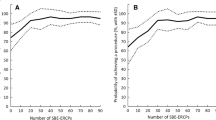Abstract
Background
Endoscopic retrograde cholangiopancreatography (ERCP) is an advanced endoscopic procedure associated with a risk of serious complications. This cohort study was designed to assess the accuracy of an endoscopic method aimed at discriminating procedures eligible to teach ERCP: patients with and without significant difficulty of selective deep cannulation (DSDC).
Methods
Clinically relevant variables were analyzed in a cohort of 400 consecutive patients (estimation group = 250 patients; validation group = 150 patients) who underwent an ERCP procedure.
Results
Multivariate analysis identified fixated duodenum, inflamed duodenum, soft major papilla, previous biliary surgery, and papilla with ectopion as independent predictors of DSDC. We constructed a model and a score system combining these five variables. The area under the ROC curve was 0.81 for the estimation group and 0.80 for the validation group. Using the best cutoff score (> 1.63), absence of significant DSDC could be excluded with high accuracy (negative predictive value = 89.2%) in 111 (44.4%) of 250 patients. Similarly, it could be excluded with the same certainty in 77 (51.3%) of the 150 patients in the validation group.
Conclusions
A combination of easily accessible variables accurately predicts the absence of significant DSDC in half the patients who underwent the ERCP procedure. This score system discriminates procedures eligible to teach ERCP.

Similar content being viewed by others
References
Loperfido S, Angelini G, Benedetti G, Chilovi F, Costan F, De Berardinis F, De Bernardin M, Ederle A, Fina P, Fratton A (1998) Major early complications from diagnostic and therapeutic ERCP: a prospective multicenter study. Gastrointest Endosc 48:1–10
Rabenstein T, Scheneider HT, Nicklas M, Ruppert T, Katalinic A, Hahn EG, Ell C (1999) Impact of skill and experience of the endoscopist on the outcome of endoscopic sphincterotomy techniques. Gastrointest Endosc 50:628–636
Miller GE (1990) The assessment of clinical skills/competence/performance. Acad Med 65:S63–S67
Peyton JWR (ed) (1998) Teaching and learning in medical practise. Manticore Europe, Rickmansworth
Freeman ML, Nelson DB, Sherman S, Haber GB, Herman ME, Dorsher PJ, Moore JP, Fennerty MB, Ryan ME, Shaw MJ, Lande JD, Pheley AM (1996) Complications of endoscopic biliary sphincterotomy. N Engl J Med 335:909–918
Jowell PS, Baillie J, Branch MS, Affronti J, Browning CL, Bute BD (1996) Quantitative assessment of procedural competence. A prospective study of training in endoscopic retrograde cholangiopancreatography. Ann Intern Med 125:983–989
Schutz SM, Abbott RM (2000) Grading ERCPs by degree of difficulty: a new concept to produce more meaningful outcome data. Gastrointest Endosc 51(5):535–539
Ragunath K, Thomas LA, Cheung WY, Duane PD, Richards DG (2003) Objective evaluation of ERCP procedures: a simple grading scale for evaluating technical difficulty. Postgrad Med J 79:467–470
Sivak MV Jr (2003) “Trained in ERCP.” Gastrointest Endosc 58:412–414
Waye JD, Bornman PC, Chopita N, Costamagna G, Ganc AJ, Speer T (2002) ERCP training and experience. Gastrointest Endosc 56:607–608
Classen M, Ruppin H (1974) Practical endoscopy training using a new gastrointestinal phanton. Endoscopy 6:127–131
Freys MS, Heimbucher J, Fuchs KH (1995) Teaching upper gastrointestinal endoscopy: the pig stomach. Endoscopy 27:73–76
Gholson CF, Provenza JM, Silver RC, Bacon BR (1990) Endoscopic retrograde cholangiography in the swine: a new model for endoscopic training and hepatobiliary research. Gastrointest Endosc 36(6):600–603
Soehendra N, Binmoeller KF (1992) Overview of interactive endoscopy simulators. Endoscopy 24(Suppl 1):549–550
Bar-Meir S (2000) Endoscopic simulator. Endoscopy 32:898–900
Neumann M, Mayer G, Ell C, Felzmann T, Reingruber B, Horbach T, Hohenberger W (2000) The Erlangen Endo-Trainer: life-like simulation for diagnostic and interventional endoscopic retrograde cholangiography. Endoscopy 32:906-910
Hochberger J, Neumann M, Maiss J, Hohenberger E, Hahn G (1998) EASIE-Erlangen active simulator for interventional endoscopy; a new bio-simulation model; first experience gained in training workshops. Gastrointest Endosc 47:AB116
Siegel JH, Korsten MA (1989) ERCP in a nonhuman primate. Gastrointest Endosc 35(6):557–559
Sedlack RE, Petersen BT, Kolars JC (2005) The impact of a hands-on ERCP workshop on clinical practise. Gastrointest Endosc 61:67–71
Choudari CP, Sherman S, Fogel EL, Phillips S, Kochell A, Flueckiger J, Lehman GA (2000) Success or ERCP at a referral center after previously unsuccessful attempt. Gastrointest Endosc 52:478–483
Author information
Authors and Affiliations
Corresponding author
Rights and permissions
About this article
Cite this article
Boix, J., Lorenzo-Zúñiga, V., Moreno de Vega, V. et al. Identification of significant difficulty of selective deep cannulation by a simple predictive model: an endoscopic scale for teaching ERCP. Surg Endosc 22, 1678–1685 (2008). https://doi.org/10.1007/s00464-007-9690-1
Received:
Accepted:
Published:
Issue Date:
DOI: https://doi.org/10.1007/s00464-007-9690-1



